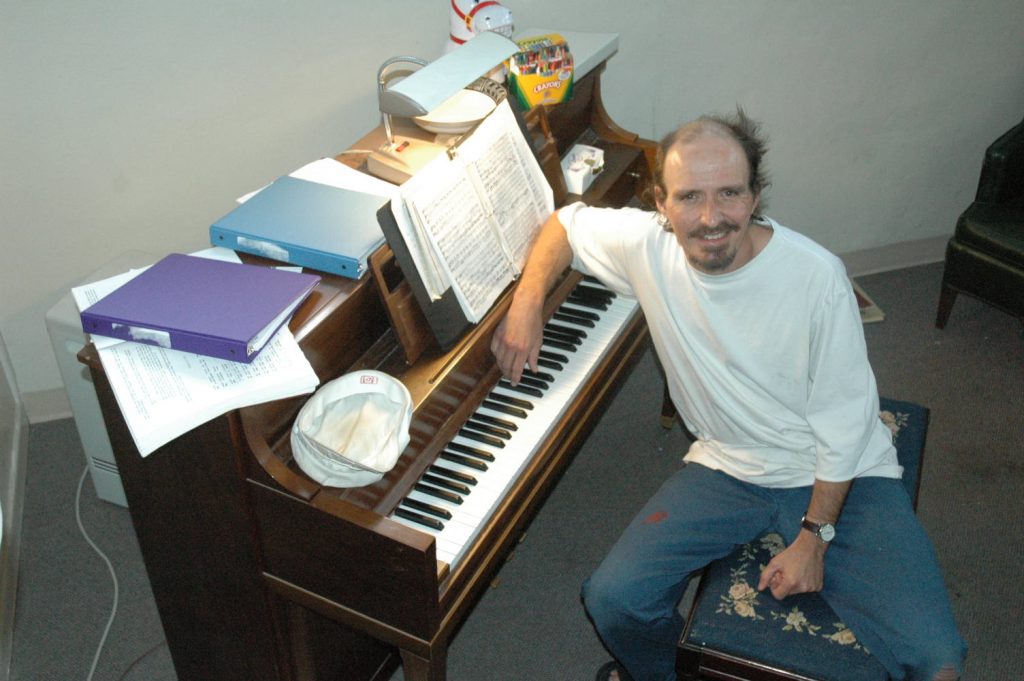Sept 19, 2018–When I heard the news that the world lost Mark Hierholzer last week, I didn’t want to believe it. I didn’t want to write about it, either.
But I changed my mind. Mark Hierholzer made a lot of people change their minds.
For those not aware of his work, Hierholzer was a graduate of the Eastman School of Music, published composer, director of the Fredericksburg Chorale, Mixed Choir and Arion Maennerchor, and, as he laughingly recalled someone introducing him saying, “a piano-playing son of a gun.”
But he didn’t say “gun.”
Here’s all you need to know about Mark Hierholzer: he wanted to change the way you experience music. In the process, he changed the way you experienced life.
I first interviewed him in 2005. What he said then still reflects the Mark Hierholzer many came to know.
His innovative approach to composition began early in life, inspired by listening to 78-rpm records of Toscanini and Horowitz.
“My parents, while not particular fans of classical music, were very discriminate about things,” Hierholzer recalled. “There was good music; there was bad. It was quite unforgiving.”
Later he realized it was this discriminating attitude that led him to believe there are things in this world that are good; there are things that are bad; and “you strive to work toward the good things.”
One of the good things he sought to create was a more vibrant way of writing, performing, and relating to music.
“I think there’s been a tradition in choral music to create a certain choral ‘sound,’” he said. “The interest is in the sound, and less on the communication of ideas. Modern culture has said there is no meaning in life. Once you have said there is no ultimate meaning to our existence in the universe, you cease to have anything to say musically. The only thing you can do then is make noise, and then you just sit around and talk about what kinds of noise you make. We never come from a choral recital and ask ‘what was the choir communicating?’”
Communication was paramount in Hierholzer’s creative process.
“Generally I write the words first,” he said. “The tone, inflection, stop, and rise of the words becomes the foundation of the music. You try to keep the sound of the word as intact as possible. The challenge is that the music does have a powerful role in conveying the idea, but that it never overpowers the words.”
Another challenge was convincing his singers to risk a new way of singing.
“The tone quality the modern choir makes is less than thrilling,” Hierholzer said. “Human voices aren’t the same; they don’t naturally blend. You have to work at getting the guys to blend with the girls. Therefore the guys start to sing like girls and the girls have to do something to make themselves not sound like girls either. It removes us from our humanity.”
Hierholzer exhorted his singers to allow their singing voices to sound as distinct as their speaking voices. The reception to this new way of vocalizing was mixed.
“I would say that it depends on the age group,” he said. “Kids tend to respond much quicker; they don’t ask questions. They see something that’s lively and they like it. Adults, because they are in a set pattern, are more prone to be resistant. But many have said–and this is what I love to hear–‘I initially hated this; now I find it really thrilling.’”
Audiences respond in much the same way.
“Many walk away saying ‘this isn’t what I came to hear,’” he admitted. “Then others say ‘I’ve never heard anything like it.’”
Hierholzer accepted the risk of “not pleasing” everyone, pointing out that even Jesus was not popular as he upturned tables in the temple.
“If you are doing something that is really valuable, you are going to have people walking away, there’s no question about it. If you do that thing that makes everyone happy, half of them are going to be asleep in the process.”
He faced those responses every time he presented a concert, whether featuring new music and student works in Dialogues & Dances, or his marathon improvisations. He would accept themes and ideas on slips of papers, then perform a spontaneous improvisation.
“True beauty always has a component of danger as well as an element of benevolence in equal measure. Awhile back I was at the coast, sitting on the second story balcony. It was an amazing image at night of the ocean out there, just roaring. There was something so powerful about it even in calm weather that brings people to that place of awe.
“In the foreground there was a swimming pool. Now, a swimming pool is fun, but you wouldn’t say the swimming pool was beautiful. There is just no comparison. One thing is beautiful beyond speech, and one aspect of that is the absolute danger of it.
“Great art, I believe, is always trying to grasp that truth that is built into the fabric of our universe. You can never really remove danger from beauty, and in short that is what these pieces are about.”
“When you articulate ideas that you believe are good for yourself, you have to believe they are good for other people,” he said. “I believe it can be good for people to let go of those things that are familiar and go to the place that for me, makes living ‘living.’ In this culture, it’s easy to say ‘I like this and you like this and that’s fine.’ I’m not willing to say that.
“If you allow yourself to get out of that routine, you’ll find yourself open to listening. It’s going to be thrilling.”
